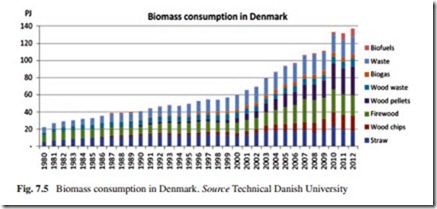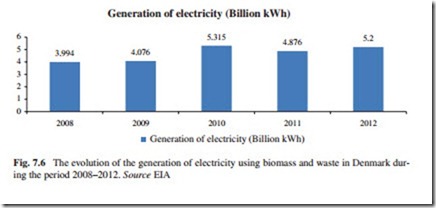Denmark
Energy production from renewable energy sources has been an important component of Denmark’s energy supply since the 1970s oil crisis. At that time, Denmark was totally dependent on imported coal and oil for the generation of electricity. The use of renewable energy has contributed to security of supply and to better management of environmental pollution. Biomass resources in Denmark are mostly straw from agriculture, wood from forestry, waste wood from industry, the biodegradable part of municipal solid waste, and to a lesser extent biogas from manure from pig and cattle farming. In 2014, a total of 70 % of renewable energy in Denmark is in the form of biomass. This consists predominately of straw and wood, but also includes biodegradable waste and biogas. Bioenergy consumption in Denmark has nearly doubled in the last decade, increased by more than a factor of twelve between 1970 and present day.
The extensive and advanced use of biomass has been facilitated to a large extent by the Danish Parliament’s Biomass Agreement of June 14, 1993, according to which the big power plants are to use 1.2 million tons of straw and 0.2 million tons of wood chips annually for CHP production. It is important to highlight that biomass, and in particular straw, which has become a Danish specialty, is a more difficult fuel for power production than coal, oil, and natural gas because first the calorific value is lower and second because of the content of chlorine and alkalis that react aggressively and corrosively under the operating condition characteristic of steam turbine plants in general, with high steam pressure and temperatures.
However, due to this agreement, the Danish utility companies have conducted a comprehensive research and development program to handle the biomass challenge. As a result, 15 biomass-based CHP plants of up to 40 MW electricity capac- ities are in operation today and straw and wood now contribute 5 % of the total Danish electricity consumption. For electricity production based on biomass, there is a substantial element of public support in the form of an additional green reward on top of the core market price per kWh.
Within the public applied-energy research and development programs, biomass has in recent decades been the largest single focus area, particularly on the development of liquid biofuels, in synergy with the development of new technologies for the transformation of biomass into heat and power. The goal is to further inte- grate the supply of energy for all sectors in line with the Danish tradition for holistic technological solutions.
According to the Annual Report 2003 of the Danish Energy Regulatory Authority, Danish technological development using straw and wood for CHP purposes can also be applied to other difficult types of biowaste. Although there have been significant additional costs in utilizing biomass instead of coal for CHP up to the present, increasing international demand is expected for the efficient Danish combustion technology for biomass. The EU has set ambitious targets for the increased utilization of biomass and CHP, and many developing countries are fac- ing swiftly growing waste problems and growing demand for electricity where the use of biowaste from, for example, the food industry could fulfill many societal needs at one stroke. Future Danish development activity will to a rising degree focus on the development of plants that are more flexible with respect to changing biofuels.
The Danish resources of biomasses available for energy production are esti- mated by the Danish Energy Agency to be 45.8 TWh per year. Today, the country is using only half of these resources, but has plans to increase the use of this type of energy source for the generation of electricity and heating during the coming years. However, the situation is not the same for all types of biomass sources. The use of organic waste and wood for energy purposes is nearly com- pletely utilized. Potentials remain in the use of straw and biogas. Around one- third of straw resources and one-tenth of biogas resources are used at present,
leaving large unused biomass potentials for straw (66 %) and biogas (91 %) in Denmark (Sterling Gregg et al. 2014). Figure 7.5 shows the biomass consumption in Denmark during the period 1980–2012.
In 2012, Denmark produced 18 % of the total energy demand (DEA 2014a). By 2020, Denmark is expected to increase its share of renewable energy to 35 %; likewise, the production of energy from biomass is expected to increase to 166 PJ (DEA 2012a). In the long term, the potential for biomass production in Denmark is between 200 and 245 PJ (excluding organic waste), so trade in biomass will be a large component of Denmark’s future energy landscape (DEA 2012a).
Generation of Electricity Using Biomass and Waste
The evolution of the generation of electricity using biomass and waste in Denmark during the period 2008–2012 is shown in Fig. 7.6.
According to Fig. 7.6, the generation of electricity in Denmark using biomass and waste increased 30.2 %. It is expected that the use of this type of energy source for the generation of electricity in the country will continue increasing during the coming years, as a result of the decision adopted by the government regarding the pro- motion of the use of renewable energy sources for this specific purpose.

